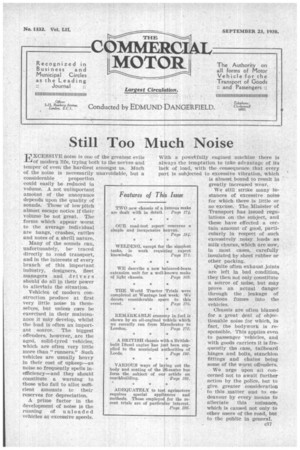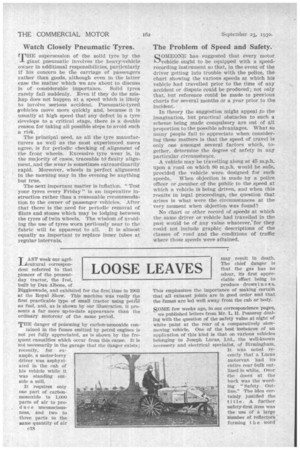Still Too Much Noise
Page 39

Page 40

If you've noticed an error in this article please click here to report it so we can fix it.
XCESSIVE noise is one of the greatest evils -ILI of modern life, trying both to the nerves and temper of even the hardiest amongst us. Much of the noise is .necessarily unavoidable, but a considerable proportion coifid easily be reduced in volume. A not unimportant amount of the annoyance depends upon the quality of sounds. Those of low pitch alniost escape notice if their volume be not great. The forms which appear worst to the average individual are bangs, crashes, rattles and notes of a shrill nature.
Many of the sounds can, unfortunately, be • traced directly to road transport, and in the interests of every branch of this important industry, designers, fleet managers and . driver s should do all in their power to alleviate the situation.
Vehicles of modern construction produce at first very little noise in themselves, but unless care be exercised in their maintenance it may develop, whilst the load is often an important source. The biggest offenders, however, .are the aged, solid-tyred • vehicles, which are often very little more than "runners." Such vehicles are usually heavy In their cost of upkeep—as noise so frequently spells inefficiency—and they should constitute a warning to those who fail to allot sufficient amounts to their reserves for depreciation.
A prime factor in the development of noise is the running of unloaded vehicles at excessive speeds. With a powetfully engined machine there is always the temptation to take advantage of its lack of load, with the consequence that every part is subjected to excessive vibration, which is almost bound to result in greatly increased wear.
We still: strike many instances of excessive noise for which • there is little or no excuse. . The. Minister of Transport has issued regulations on the subject, and these have effected a certain .amount of good, particularly in • respect of such excessively noisy loads as milk churnsovhich are now, in most cases, carefully insulated by sheet rubber or other packing.
Quite often exhaust joints are left in bad condition, they then not only constitute a source of noise, but may prove an actual Clanger through the leakage of noxious fumes into the vehicles.
Chassis are often blamed for a great deal of objectionable noise for which, in fact, the bodywork is responsible. This applies even to passenger 'vehicles, and with goods carriers it is frequently the ease, tailboard hinges and bolts, stanchion fittings and chains being some of the worst offenders. We urge upon all concerned not to await further action by the police, but to give. greater consideration to this .matter and to endeavour by every means to alleviate this nuisance, which is caused not only to other users of the road, but to the public in general.
Watch Closely Pneumatic Tyres.
rpHE supersession of the solid tyre by the -Igiant. pneumatic involves the heavy-vehicle owner in additional responsibilities, particularly if his concern be the carriage of passengers rather than goods, although even in the latter ease the matter which we are about to discuss is of considerable importance. Solid tyres rarely fail suddenly. Even if they do the mishap does not happen at a speed which is likely to involve serious accident. Pneumatic-tyred rehicles move more quickly and, because it is usually at high speed that any defect in a tyre develops to a critical .stage, there is a double reason for taking all possible steps to avoid such a risk.
The principal need, as all the tyre manufacturers as well as the most experienced users agree, is fer periodic checking of alignment of the front wheels. Excessive tyre wear is, in the majority of cases, traceable to faulty alignment,.and the wear is sometimes extraordinarily rapid. Moreover, wheels in perfect alignment In the morning may in the evening be anything but true.
The next important matter is inflation. "Test your tyres every Friday" is an imperative instruction rather than a reasonable recommendation to the owner of passenger vehicles. After that there is the need for periodic removal of flints and stones which may be lodging between the tyres of twin wheels. The wisdom of avoiding the use of tyres worn perilously near to the fabric will be apparent to all. It is almost equally as important to replace inner tubes at regular intervals. The Problem of Speed and Safety.
SOMEON.4 has Suggested that every motor Kivehiele ought to be equipped with a speedrecording instrument so that, in the event of the driver getting into trouble with the police, the chart showing the various speeds at which hiS vehicle had travelled prior to the time of any accident or dispute could be produced; not only that, hut reference could be made to previous charts for Several 'months or a year prior to the incident.
In theory the suggestion might appeal to the imagination, but practical obstacles to such a scheme being made compulsory are out of all proportion to the possible advantages. What so many people fail to appreciate when considering these matters is that the speed of travel is only one amongst several factors which, together, determine the degree 'of safety in any particular circumstance.
A vehicle may be travelling along at 45 m.p.h. upon a road on which 80 m.p.h. would be safe, provided the vehicle were designee for such speeds. When objection is made by a police officer or member of the public to the speed at which a vehicle is being driven, and when this results in legal proceedings, the question that arises is what were the circumstances at the very moment when objection was found?
No chart or other record of speeds at which the same driver or vehicle had travelled in the past would be of any value whatever:for they could not include graphic descriptions of the classes of road and the conditions of traffic where those speeds were attained.












































































































